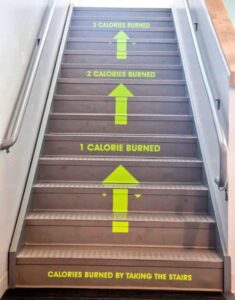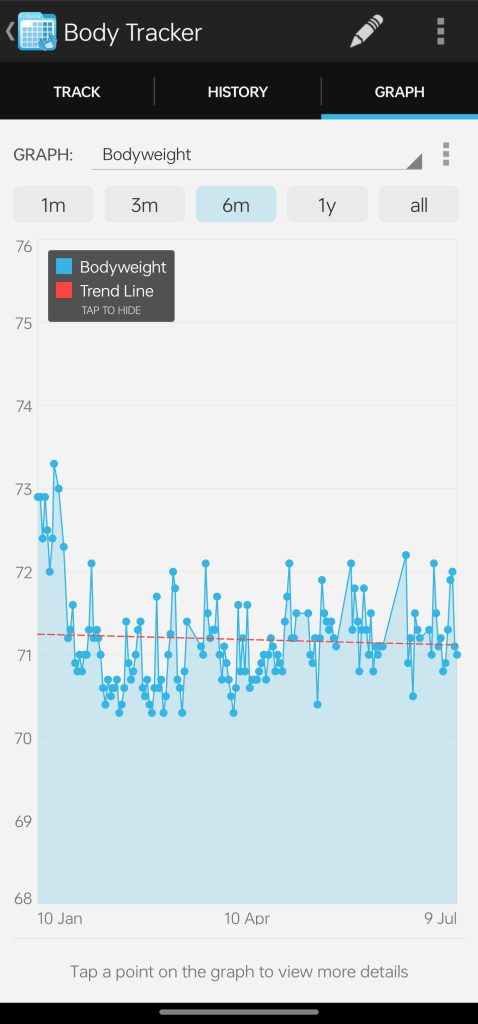If you’re thinking about changing your body working on your nutrition and lifestyle, look at what 6 months of progress look like, this will significantly help you reach your goal. Oh, this is 100% a real story.
This is the story of my client, a woman named K.
A Busy Life Abroad
K. is in her thirties, with a demanding career that keeps her busy around the clock. She lives abroad, far from her family, who she visits once or twice a year to enjoy holidays, reconnect with loved ones, and indulge in the comforting soul food of her home country.
Long Days and Low Energy
Her work schedule is intense. She often has back-to-back meetings that last until late in the evening, and by the time she’s done, she’s left with little to no energy to think about working out or cooking a healthy meal: take away, instant noodles or fast food are often the go-to option. This harsh routine made it hard to prioritize her own well-being.
Taking the First Step
K. reached out to me for help. She wanted a simple starting point: a two-day-a-week, one-hour workout plan that would eliminate the stress of figuring out what to do at the gym. The goal was to free up her mental energy so she could just focus on lifting and get it done efficiently.

Overcoming Gym Anxiety
Let’s face it: joining a gym can be intimidating, especially if you don’t have much experience and no plan to follow. Starting with the straightforward, structured program I crafted for her helped K. overcome that initial obstacle and gave her the confidence to show up and start moving.

Building Consistency
We began working remotely on a two months training program with two strength training sessions a week. At first, even that occasionally felt like a stretch. With her tough schedule and long workdays, fitting in workouts was sometimes a challenge. Some weeks, even two sessions seemed nearly impossible. But K. didn’t give up. She stuck to the plan through those early struggles, slowly building momentum and noticing she was getting stronger.
Leveling Up
After a few 2 months programs, K. felt ready to take things further. She asked to add an extra workout day, bumping her training up to three sessions a week. Her progress was steady and strong. She grew more confident, her strength increased, and she started to trust the system tailored for her.
The Holiday Setback
Then came the end-of-year holidays. K. traveled back to her home country, where she continued to work remotely while balancing family time, festive gatherings, and plenty of amazing soul food. With so much happening, her consistency with training slipped. She started to notice changes in her body, her clothes felt tighter, and she felt her body weight increasing and a general sense of anxiety looming.
New year new goal: fat loss
When she returned in February, K. scheduled a call and opened up about her concerns. She felt uncomfortable in her body and wanted to lose fat but wasn’t sure where to start or what steps to take to make it right.
If you know me, you can probably guess my first thought: “You need to be in a calorie deficit to lose fat, so it’s time to look at your nutrition and your calorie intake.”
And while that’s absolutely true, I also knew that there were more, effective ways to deliver that message, ways that would support her rather than overwhelm her.
The word DIET is one letter away from DIE and...it's scary
The simple idea of dieting is unsettling and grim-looking. When we talked about nutrition, K. told me:
“I don’t want to be on a diet, I want to eat foods that I like and enjoy, not be starving and sad”

I couldn’t agree more. Strictly speaking “diet” simply means:
“the kinds of food that a person, animal, or community habitually eats
but this became more of a synonym of:
let’s starve for weeks and weeks without any plan taking joy out of every meal
But I digress.
When we first started talking about fat loss, K. was clear about one thing: she didn’t want to be on a “diet.” Just the idea of it made her feel concerned, discouraged, and even a little sad. She associated dieting with restriction, pressure, and giving up the foods she loved.
To her surprise, I shared that my approach to nutrition is nothing like the rigid plans she wanted to avoid. In fact, it’s the opposite. My philosophy is simple:
Let’s find out what works for you and only you.
That meant having a flexible approach to nutrition that fit her lifestyle.
Here is what I believe nutrition should be to have sustainable progress
I don’t believe in cutting out entire food groups.
The only way to lose fat is by being in a calorie deficit—but how you get there can (and should) include a wide variety of foods, even the ones that bring you joy, regardless of whether they’re considered “un-healthy.”
No single food will make you gain fat unless it contributes to a long-term caloric surplus.
Your success depends on long-term consistency, not perfection.
One snack, one meal, a day, a weekend even an entire week where things feel off-track won’t destroy your long term progress.
Tracking calories is a helpful learning tool, but it’s just that: a tool. There’s always room for flexibility.
Keeping a flexible and sustainable approach
K. and I talked through all of this carefully. It was essential to reassure her that she could build a sustainable relationship with food, one that allowed for all the foods she enjoyed, as long as they were included in the right quantities and in the right context.
This mindset shift was crucial. It helped her feel safe and empowered to take control of her nutrition without fear, which played a major role in her steady 6 months of progress you’ll see below both physically and mentally.
One thing that I made sure was very clear with K. is that you can’t choose where you lose fat, you can’t target belly/back/arms fat in any way and whoever sells you plans and programs to do so is basically scamming you.
The benefit of learning how to count calories
When K. and I discussed the role of calories in fat loss, she was open to trying calorie counting—not as a strict rulebook, but as a tool to better understand her current eating habits and to help her plan her direction moving forward. (here is a guide to counting calories)
The aha! Moment
As she started tracking, K. was surprised to learn that some of her regular go-to foods were significantly more caloric than she had assumed. But instead of cutting them out, she learned how to manage portion sizes. This way, she could still enjoy her favorite meals while staying within her daily calorie target.
(We used my free calorie calculator, which you can try here too.)
Navigating Workday Lunches
K. was honest from the start: measuring lunch at work simply wasn’t realistic. She didn’t have time to cook or bring meals from home, and she didn’t want that added stress. So together, we came up with a flexible, realistic and practical strategy for her midday meals:
Focus on lunch options that include a good source of protein
Add veggies when possible
Keep sauces on the side as they’re often sneaky sources of extra calories
Eat until about 80% full
Try your best, but don’t stress over perfection
This approach allowed her to make mindful choices at work without obsessing over numbers or feeling restricted or anxious
Prepping for success and to reduce stress
Evenings were easier to manage, so K. began prepping her dinners in advance. This simple step was a game-changer as after long days of work and lifting, having meals mostly ready meant less stress and more consistency.
Trial, Error, and Progress
There was definitely some trial and error in the beginning, but with continued support, K. found a calorie-counting rhythm that worked for her lifestyle, her food preferences, and her goals. She didn’t have to give up the foods she loved but just make smarter, more intentional choices.
This flexible approach to tracking and eating played a key role in her path and lead to her amazing 6 months of progress, helping her build healthy habits without sacrificing her enjoyment of food.
Measure your body weight every day no matter what
The Power of the Scale
This is where things get interesting and this is also one of the most crucial parts of the fat loss process: daily weight tracking.
Measure your body weight every day and record it.
That’s it. It’s just data.
Your body weight is simply a number. It’s a data point a small tick on a box when your day begins. It’s not a judgment, not a performance score, and definitely not a measure of your worth.
Let me emphasize this clearly: It’s Just A Number.
Why Daily Weigh-Ins Matter
By tracking body weight every single day, you build a valuable dataset that helps you understand your body’s trends and patterns over time.
When K. started daily weigh-ins, she was understandably concerned. Her weight seemed to bounce up and down with wild swings, even though she was doing her best to stay in a calorie deficit. Some mornings she was –1 kg and thrilled; others she was +1 kg and felt panicked.
What do the fluctuations mean?
These swings are completely normal. And yes, they can feel frustrating, but there are solid reasons behind them. Here are a few real-life examples from K.’s experience:
She had an intense lifting session: her muscles held onto more water for recovery, increasing her weight.
Her period was approaching, again, more water retention.
She had dinner out with friends to celebrate the end of a long week and still felt full the next morning.
One night she ate less because she wasn’t hungry and was lighter the next day.
Stress from work may have caused her body to hold onto extra water.
Despite these fluctuations, K. committed to recording her weight every day just like we had agreed. And over her 6 months of progress, that data became incredibly useful.
Trends over time, not day-to-day
The first 6 to 8 weeks measuring your body weight every day in a calorie deficit are especially important. This is when you begin to see whether your plan is headed in the right direction.
Daily weigh-ins allow us to build a trend line that shows you a broader picture filtering out the noise of daily ups and downs. That trend line tells the real story: whether you’re on track toward your goal. In K.’s case, that goal was fat loss.
If the trend isn’t going the way you expect it doesn’t mean failure, it simply means there may be small adjustments to make talk to your coach and review what is going on honestly. Either way, the data and your coach are there to guide the next steps.
Celebrating 6 months of progress
Just a few days ago, I received a happy email from K. with a screenshot that said it all.
Her consistency, her mindset shift, and her willingness to track without fear were all paying off. It was a major milestone in her 6 months of progress, and one she absolutely earned.
Look for yourself:
look at the ups and downs and how crazy they are.
Daily fluctuations and short term anxiety
Anyone would feel discouraged just by looking at the ups on the scale.
You might start thinking:
It’s not working.
I’m not doing enough.
I should cut out waaaaaay more foods.
I need to do a lot more cardio (which doesn’t necessarily help here is why).
No more cakes (nope you can absolutely have that slice and here is also why).
No more carbs (I don’t understand why carbs really get beaten).
I’m just going to do the Keto diet (and that is the wrong answer here’s why).
These are such common thoughts, and they all come from the same place:
frustration mixed with misunderstanding.
But they don’t reflect the truth of how long term progress really works.
K.’s mindset shift
Now look at K. She had those moments too but she didn’t let them stop her.
When she had doubts, she didn’t spiral she reached out, asked questions, and stayed open to support. Most importantly, she kept going forward, even when it wasn’t easy.
She didn’t cut out social meals or drinks with friends. Instead, she learned how to fit them into her lifestyle in a way that didn’t derail her goal.
Once she started understanding how the scale works, she stopped reacting emotionally to a few days of upward movement.
Because now, she gets it: sustainable change happens over time, and weight naturally fluctuates every single day.
A long-term vision that works
K.’s ability to push through the mental noise and trust the process is a major part of her 6 months of progress. The mindset she developed: balanced, informed, and steady helped her make changes that stuck.
And if you need even more proof that this works? Look at my own data.
No BS
My last 6 months of progress have been driven by a simple goal: maintain my weight even during constant business travel overseas with hectic weeks when I can’t cook a single meal.
I’ve done it using the exact same mindset I coach my clients on:
No extremes, no restriction, no guilt just smart choices, consistency, and perspective.
Judge by yourself:

See the trend line in red? It’s basically stable despite the insane ups and downs I had.
Bottom line
K. trusted the process. It wasn’t easy at the start, but she kept her eyes on the bigger picture. Over time, she learned to focus on small, steady improvements recognizing the challenges, adjusting as needed, and never losing sight of her long-term vision.
Her confidence has grown. Her strength keeps improving. And her body is changing bit by bit toward the version she’s working hard for.
This is what real 6 months of progress looks like.
So here’s the takeaway:
Focus on the long term. Find an approach that works for you and only you. And if you feel stuck, seek a coach who supports you in building a sustainable, empowering plan but not some “cut-all-the-food” crash diet scam.
You deserve a method that lasts and progress you can be proud of.

